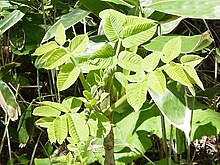Toxicodendron vernicifluum
| Lacquer Tree | |
|---|---|

| |
| Scientific classification | |
| Kingdom: | |
| (unranked): | |
| (unranked): | |
| (unranked): | |
| Order: | |
| Family: | |
| Genus: | |
| Species: | T. vernicifluum
|
| Binomial name | |
| Toxicodendron vernicifluum (Stokes) F. Barkley
| |
Lacquer Tree (Toxicodendron vernicifluum or formerly Rhus verniciflua), also called Varnish Tree, Japanese lacquer Tree, Japanese Varnish Tree and Japanese Sumac, is a species of genus Toxicodendron (formerly Rhus) that grows in East Asia, in regions of China, Korea and Japan. The trees are cultivated and tapped for their toxic sap, which is used as a highly durable lacquer to make Chinese, Korean and Japanese lacquerware.
The trees grow up to 20 m tall with large leaves, each containing from 7 to 19 leaflets (most often 11-13). The sap contains the allergenic compound urushiol, which gets its name from this species' Japanese name urushi (漆). Urushiol is the oil found in poison ivy that causes a rash. Other names for this species include (Note: the term "varnish tree" is also occasionally applied to the Candlenut, Aleurites moluccana, a southeast Asian tree unrelated to Toxicodendron).
Uses

A caustic, toxic sap is tapped from the trunk of the Lacquer Tree to produce lacquer. This is done by cutting the trunk of a 10 year old tree horizontally 5-10 times, and then collecting the greyish yellow sap that exudes. The sap is then filtered, heat-treated, or coloured before applying onto a base material that is to be lacquered. This liquid is commonly called urushi. Curing the applied sap requires "drying" it in a warm, humid chamber or closet for 12 to 24 hours where the urushiol polymerizes to form a clear, hard, and waterproof surface. In its liquid state, urushi can cause extreme rashes, even from vapours. Once hardened, urushi reactions are possible but less common.
Products coated with urushi are recognizable by an extremely durable and glossy finish. Urushi lacquer has more applications than could be listed here, but common uses include tableware, musical instruments (especially shakuhachi bores and taiko drums), fountain pens, jewellery, and yumi (bows). With Wajima-nuri (lacquerware from the town of Wajima) at the head of the list, there are various types of urushiware. The cinnabar-red is highly regarded. Unpigmented urushi is dark brown but the most common colors of urushi finishes are black and red, from powdered pigments of iron and ferric oxide, respectively. Urushi is painted on with a brush and is cured in a warm and humid environment.
Artistic application and decoration of urushi can be a long process, requiring many hours or days of careful and repetitive layers and drying times. The creation of a single piece of urushi art, such as a bowl or a fountain pen, may take weeks to months to complete.
Urushi is a very strong adhesive.
The leaves, seeds, and the resin of the Lacquer Tree are sometimes used in Chinese medicine for the treatment of internal parasites and for stopping bleeding. Compounds butein and sulfuretin have antioxidative, and aldose reductase and advanced glycation endproducts inhibitory effects.[1]
References
- Duke. J. A. and Ayensu. E. S. Medicinal Plants of China Reference Publications, Inc. 1985 ISBN 0-917256-20-4
- Stutler, Russ. "A Little more information on Urushi". December 2002.
- Suganuma, Michiko. "Japanese lacquer".
- ^ Lee EH, Song DG, Lee JY, Pan CH, Um BH, Jung SH (2008). "Inhibitory effect of the compounds isolated from Rhus verniciflua on aldose reductase and advanced glycation endproducts" ([dead link]). Biol. Pharm. Bull. 31 (8): 1626–30. PMID 18670102.
{{cite journal}}: Unknown parameter|month=ignored (help)CS1 maint: multiple names: authors list (link)
See also
External links
- Gallery of urushi art
- "The Urushi Project", a website about urushi around the world, with many references
- URUSHIGEYOSHI - Alle Sou-nuno,honkataji,-arbeit
